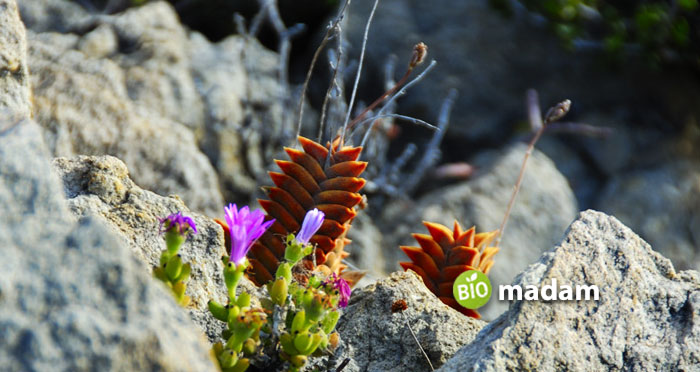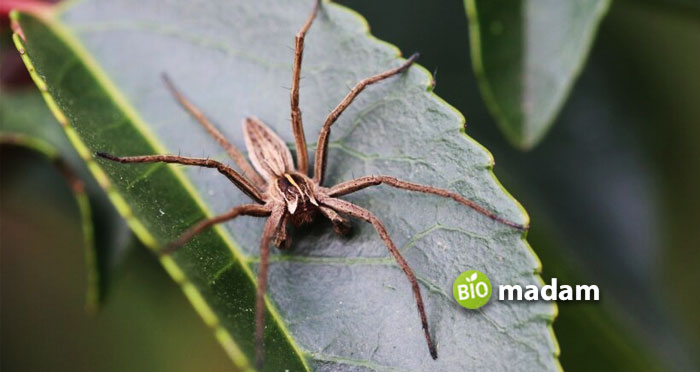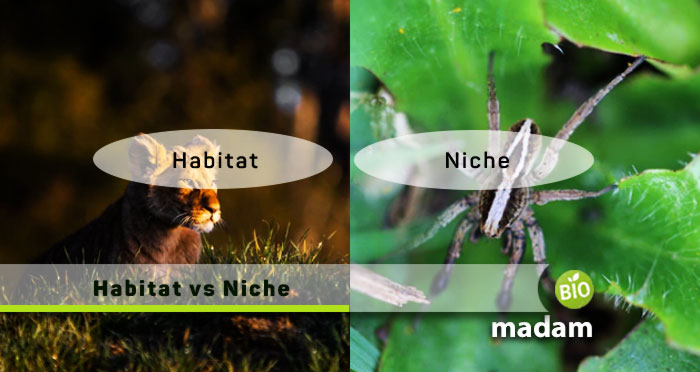When discussing our environment, communities, ecosystems, ecologies, habitats, and niches are important words which are often confused and inter-used. However, in some situations, these terms represent specific situations. The main difference between habitat and niche is the organism’s role in the system. Habitat is where an organism or a population lives, while niche is the organism’s role in that ecosystem. Let’s tell you more so you can understand habitats and niches better.
Comparison Table
| Characteristics | Habitat | Niche |
| Definition | Organism’s home | Organism’s role in habitat |
| Nature | Physical space | A function |
| Specificity of Specie | No | Yes |
| Variability | No | Yes |
| Impact | Yes | No |
| Example | Grasslands, lakes, mountains, deserts | Mice and moles |
What is a Habitat?
Habitats are places where species and subspecies can find the resources to thrive and propagate. A species’ habitat is a material representation of its ecology type and requirements. It is a home, serving as the primary source of food, water, and shelter for a particular plant, fungi, animal, or another organism.
Ecologists examine habitats of various geographical sizes. They include microhabitats which provide an individual with the resources necessary to carry out a specific activity (such as foraging or reproducing) to macrohabitats. Macrohabitats give everything a population of a particular organism needs to survive. Many components come together to form a healthy environment.
Habitats comprise biotic and abiotic components. Biotic components are those that contain some form of life. Abiotic factors do not involve living organisms. The abiotic factors may include soil, moisture, range of temperature, and light intensity. Biotic factors will consist of food availability and predators’ presence or absence. They contribute to the organism’s role in the food chain and food webs.
Every species has particular habitat requirements, with habitat generalist species able to thrive in various environmental conditions, while habitat specialist species require a minimal set of factors to survive.

Types of Habitats
Because different forms of life need distinct environments to thrive, nature features a variety of habitats in our biomes and biosphere. There are two primary categories of habitats: terrestrial and aquatic.
Terrestrial Habitat
A terrestrial habitat has a primary location on the ground. Habitats on land can be either wholly natural or partially artificial, like national parks or biosphere reserves. Caves, deserts, farms, forests, grasslands, shorelines, wetlands, etc., are just some of the many terrestrial habitats. Here are a few terrestrial habitats:
Forrest: Trees create the biome of forests and woodlands. Earth’s forests cover nearly a third of its surface. They are essential for life on earth because they provide a natural habitat for animals, plants, and fungi. Over 300 million species live in forests.
Grassland: Grasslands predominantly comprise grasses with some trees or plants. Grasslands are tropical (savanna) and temperate grasslands. Wild grass biome includes African savanna and midwest grasslands; these natural environments exist worldwide except for Antarctica. Elephants, giraffes, hyenas, jackrabbits, lions, rhinos, warthogs, and zebras inhabit grasslands.
Deserts: The lack of moisture makes some areas deserts and others scrublands. They are some of the driest places on Earth, which makes survival quite tricky. Desert animals and plants can survive in highly arid environments. Some deserts have a relatively mild climate, despite common belief. Due to its low annual precipitation, Antarctica qualifies as a desert (interior parts).
Mountains: Mountains are high landforms. High elevations make mountain regions colder. In these regions, plants and animals have adapted to the climate. Bighorn sheep, brown and black bears, grizzly bears, mountain goats, lions, and antelope inhabit the mountains (not found in the same region). As elevation increases, forests become sparser.
Aquatic Habitat
The aquatic biome includes the world’s all water bodies. Freshwater, marine, and coastal habitats are common aquatic habitats.
Freshwater: The environment of freshwater habitats has water like rivers, lakes, ponds, and streams. It is common to find aquatic animals like fish, frogs, ducks, lotuses, and water lilies in freshwater environments.
Oceans: The world’s marines and seas make up most of the earth’s habitats. Many organisms call the ocean home, from microscopic plankton to the blue whale, the world’s largest animal.
What is a Niche?
An organism’s ecological niche is its typical range of activity and role within a given ecosystem. Both biotic and abiotic elements influence a species’ niche, affecting the species’ chances of survival and long-term viability.
For example, yeasts and bacteria perform both excellent and harmful ecosystem functions. Like bacteria, other life forms also have positive and negative effects on the ecosystem and other organisms, but every organism and microorganism contributes to a healthy planet.
Ecological niches are essential for the continued viability of a species. This species can flourish and fulfill a vital niche in the correct setting. Only species would be able to thrive with ecological niches, throwing the ecosystem out of kilter.

Types of Niche
There are three types of niches based on how species from different genera interact with their surroundings. These include spatial, trophic, and multidimensional niches.
Spatial Niche
The term “spatial niche” describes a species’ space within its habitat. It may be called the habitat and ecosystem’s interaction. Due to spatial niche partitioning, a wide variety of species can coexist in the same ecosystem.
As a result of this phenomenon, several organisms can divide their ecology into distinct territories. Animals can create nutritional barriers in addition to geographical ones, as it creates separation in different species.
Trophic Niche
A species’ trophic niche in a food web refers to its position. There is a separation between animals at the bottom of the food chain and those at the top. An organism can be anything from producers to consumers and decomposers. It means, the entire ecosystem consists of autotrophs, heterotrophs, and saprotrophs. Quaternary consumers eat tertiary and secondary consumers.
Multidimensional Niche
Multidimensional niches indicate where a species falls along a spectrum of environmental conditions. In a multidimensional niche, the concept of a fundamental niche is combined with the existing constraints. The term “fundamental niche” describes an organism’s potential niche if there are no external constraints, such as predators. Similar-living species, such as rabbits and groundhogs, often face off against one another over the limited food and housing space available to survive. It also helps understand the climate’s effect on biomes, which leads to increased competition.
Difference between Habitat and Niche
Definition
Habitat
A habitat is defined as an organism’s home or area where it lives.
Niche
On the other side, an organism’s niche describes its specialized job or function within the system.
Function
Habitat
Habitat studies how a community of organisms responds to its niche.
Niche
Niche, in contrast, examines how an organism responds to its surroundings.
Variety
Habitat
Several distinct niches make up the habitat due to different organisms living in a shared space.
Niche
One species’ niche may overlap with another comparable niche, but there must be significant differences between them.
Specie-Specific
Habitat
Many different organisms can live in the same habitat since it is not species-specific.
Niche
As its name implies, a niche is solely suitable for one particular species.
Variability
Habitat
A creature’s habitat does not change during its lifetime.
Niche
The niches of various life forms can shift more frequently than the seasons.
Impact
Habitat
The habitat can affect a species’ niche.
Niche
On the contrary, a species’ niche develops directly from its habitat, and rarely does it affect that habitat.
Examples
Habitat
A few examples of habitat are grasslands, lakes, mountains, deserts, and more.
Niche
Kiwis and other land-dwelling birds eat seeds and insects like rodents like mice and moles.
The Bottom Line
Habitat and niche are often used interchangeably due to their impact on one another. Many people think that they are more or less the same. However, one fundamental difference between the two makes it easy to understand their role in different biodiversities. Habitat refers to the space or area an organism or population lives in. And the organism’s role in the ecosystem is called its niche. The habitat may influence the organism’s niche, but the niche typically does not impact the habitat.
FAQs
What are things a niche includes?
The three main elements of an organism’s niche include how it behaves, what it eats, and how it impacts the ecosystem. It includes everything an organism does to the environment.
What are the 3 main niches?
The three main niches are tropical, spatial, and multi-dimensional. They all represent different levels of habitat occupancy and the organism’s impact on the ecosystem.
What is an example of a niche in the rainforest?
Epiphytes are the most common example of a niche in the rainforest. They may also form small ecosystems of their own in the canopy niche with various diversities. They can hold over eight liters of water in their upturned and stiff leaves.
What is an example of a habitat?
Any organism’s living space is called its habitat. So, a fish’s natural habitat is the sea, and squirrels usually live in forests. At the same time, your pet dog’s habitat is its dog house, though it’s not his natural habitat.

Jeannie has achieved her Master’s degree in science and technology and is further pursuing a Ph.D. She desires to provide you the validated knowledge about science, technology, and the environment through writing articles.

